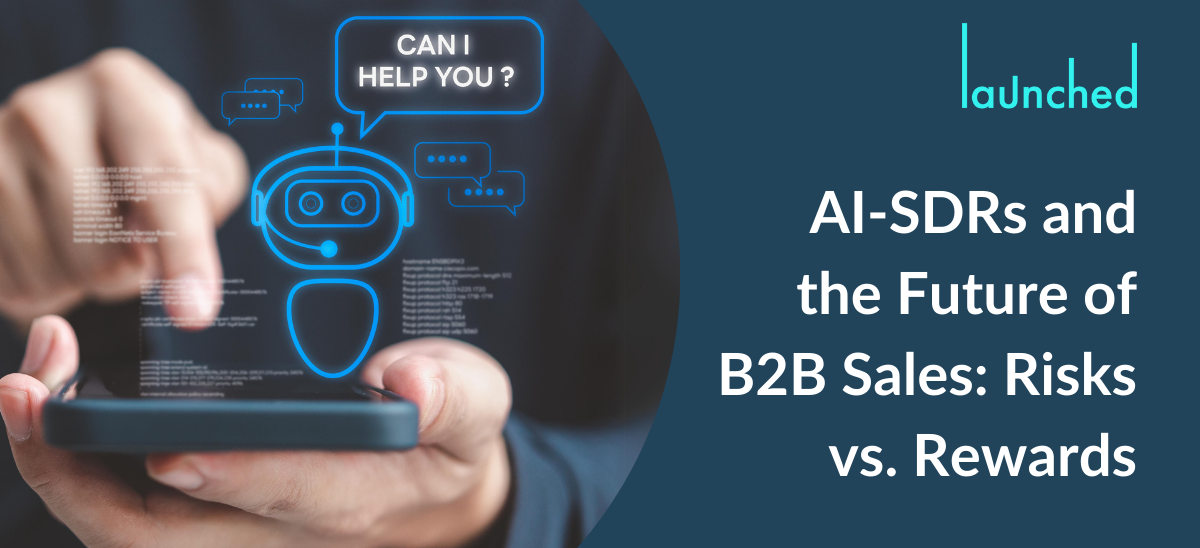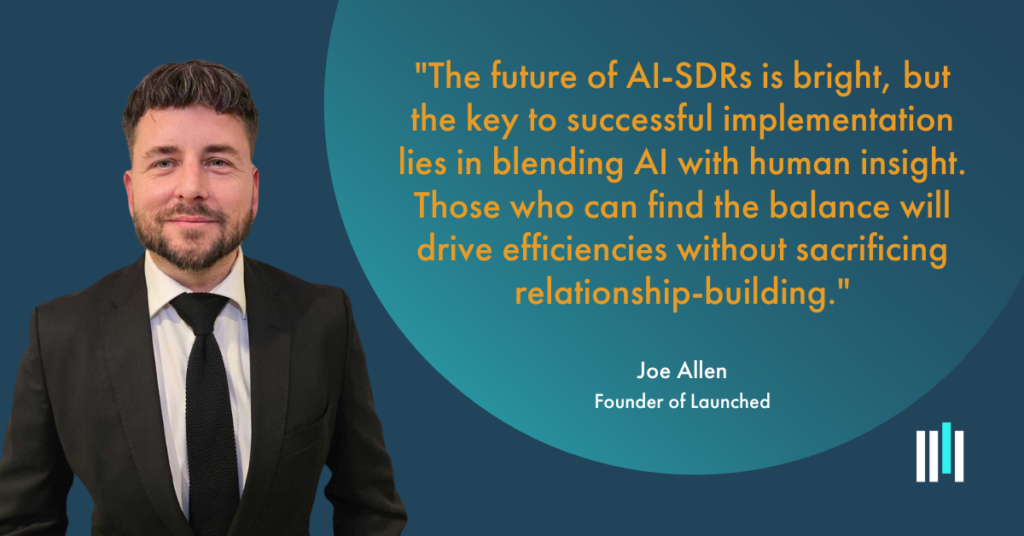AI-SDRs and the Future of B2B Sales: Risks vs. Rewards

The advent of AI-driven sales development representatives (AI-SDRs) is set to revolutionise the B2B sales landscape. These tools are designed to handle routine tasks like prospecting, lead qualification, and nurturing at scale, freeing human sales teams to focus on more strategic conversations. The automation of these processes represents an evolution in how B2B sales teams interact with leads, promising both significant rewards and notable risks.
Infographic: AI-SDRs in the B2B Sales Process
Visualize the key benefits and challenges of AI-SDRs with a simple infographic to break down complex ideas for your readers.
Rewards of AI-SDRs for B2B Companies
- Increased Efficiency and Scalability: AI-SDRs can engage with thousands of leads simultaneously, something human SDRs cannot match. They process large amounts of data and execute personalized outreach at scale, leading to more efficient lead nurturing and qualification. This allows businesses to rapidly expand their reach without needing to scale up their human resources proportionally.
- Consistent Lead Nurturing: One of the key challenges in B2B sales is the ability to nurture leads over time, especially those not ready to convert immediately. AI-SDRs can engage leads consistently, keeping them warm and informed while providing relevant content. This improves the chances of conversion when the lead is ready to buy.
- Data-Driven Insights: AI systems continuously learn from interactions, gathering valuable data on prospects. They can analyse patterns, predict customer needs, and identify potential high-quality leads with more accuracy than humans alone. This results in smarter targeting, improving sales conversion rates.
- Cost Efficiency For businesses facing budget constraints, AI-SDRs present a cost-effective solution by handling repetitive tasks. The cost to run AI-SDRs is generally lower than hiring, training, and maintaining large SDR teams, enabling companies to optimise their resources.
- Faster Response Times AI-SDRs can engage leads 24/7, ensuring that no opportunities are missed due to time zone differences or the availability of human SDRs. Quick response times enhance lead engagement, giving companies a competitive edge.
Risks of AI-SDRs for B2B Companies
- Lack of Human Touch B2B sales often require high-touch, relationship-driven interactions, especially for complex solutions. AI-SDRs, while capable of handling initial outreach, lack the empathy, intuition, and personal rapport that human sales reps bring to the table. This could result in leads feeling disconnected or undervalued, particularly if the conversation becomes too robotic or generic.
- Complexity of Deployment Integrating AI-SDRs into existing sales processes requires careful planning and resources. It involves setting up sophisticated algorithms, training models on business-specific data, and maintaining the system to ensure optimal performance. Small misconfigurations can result in inaccurate targeting, poor lead handling, or alienating potential customers.
- Risk of Over-Automation Over-relying on AI in sales could result in losing important human insights and creativity. While AI-SDRs are efficient at processing information and conducting outreach, they may miss nuances or key signals from leads that a human SDR would notice. This could lead to missed opportunities or damaged relationships.
- Data Privacy and Security Concerns AI systems rely on vast amounts of data to function effectively. For B2B companies, safeguarding customer data is paramount, and any breaches could lead to severe reputational and financial repercussions. Ensuring that AI-SDRs comply with stringent data privacy regulations such as GDPR or CCPA adds an extra layer of responsibility.
- Initial Setup Costs Although AI-SDRs offer long-term cost savings, the initial investment in building or adopting these systems can be substantial. Companies must consider the costs of implementation, training, and potential integration with other marketing and sales tools. This could be a deterrent for smaller organisations with limited budgets.

“The future of AI-SDRs is bright, but the key to successful implementation lies in blending AI with human insight. Those who can find the balance will drive efficiencies without sacrificing relationship-building.”
How to Overcome the Risks
Augment AI with Human Oversight: To address the risk of losing the human touch, B2B companies can deploy a hybrid model where AI-SDRs handle repetitive tasks while human SDRs step in for more nuanced interactions. Human oversight ensures that AI remains focused on data-heavy tasks like lead qualification and engagement, while people handle relationship-building and strategic conversations.
Tailored AI Implementation: To avoid deployment complexity, businesses should start small, implementing AI-SDRs in specific parts of the sales process, such as lead qualification or initial outreach, before scaling up. Partnering with experienced vendors or building cross-functional teams involving IT, sales, and marketing can help ensure smoother integration.
Balance Automation and Personalisation: To prevent over-automation, companies should establish rules that trigger human intervention at key points in the sales funnel. For example, once a lead reaches a certain stage of engagement or expresses interest in a high-ticket product, a human SDR should take over the interaction. This way, AI manages routine tasks while humans focus on critical touchpoints.
Implement Robust Data Security Measures: To address privacy concerns, companies need to implement strict data governance frameworks that comply with regulations such as GDPR or CCPA. This includes encrypting customer data, conducting regular security audits, and setting clear policies on data usage. Additionally, AI systems must be programmed to only access relevant and necessary data to minimise risk.
Invest in the Right Training and Tools The initial costs of AI-SDRs can be offset by ensuring that the system is well-integrated into the existing sales and marketing tech stack. Businesses should also invest in training for employees, enabling them to understand the AI’s capabilities and how best to leverage it in their day-to-day tasks. Optimising the AI-SDR through continuous feedback and performance monitoring will help maximise its value.
The Risk-to-Reward Ratio
The balance between the risks and rewards of AI-SDRs in B2B sales depends on a company’s specific situation and objectives. For organisations that prioritise scaling efficiently, automating repetitive tasks, and using data-driven insights to inform decision-making, the rewards often outweigh the risks. However, businesses that thrive on personal relationships or have a complex, high-touch sales process might find the risks to customer satisfaction and brand image more challenging to overcome.
In many cases, the optimal approach is a hybrid model, where AI-SDRs handle the initial stages of lead qualification and nurturing, while human SDRs take over when personal interaction is essential. This allows companies to leverage the efficiency of AI while maintaining the human touch critical to building trust and closing deals.
Actionable Takeaways
- Start small with AI-SDRs and scale up gradually.
- Use human oversight to maintain a balance of automation and personalisation.
- Ensure data privacy by implementing robust security frameworks.
- Invest in training for both AI implementation and integration with existing processes.
Is Your Sales Process Ready for Nova?
Join our upcoming demo at SaaStock to see how Nova, Launched’s AI-SDR, can transform your B2B sales process. Sign up now to secure your spot!
#B2BSales #B2BMarketing #SalesAutomation #AIinSales #SalesTech #SalesEnablement #LeadGeneration #SalesDevelopment #AI #ArtificialIntelligence #TechInnovation #SaaS #Fintech #Healthtech #Martech #Ecommerce #TechTrends #SalesLeadership #DigitalTransformation #EnterpriseTech #FutureOfWork #Innovation #CustomerSuccess #GrowthHacking #Automation #SaaStock #SaaStock2024 #SaaSFounders #SaaSLeaders
About Author:
Launched is a comprehensive sales and marketing platform designed to transform the way businesses engage with leads and drive revenue. Powered by advanced AI technologies, including its flagship AI-SDR Nova, Launched offers a suite of tools that streamline prospecting, lead qualification, and nurturing. Beyond automation, the platform provides intent data and website monitoring to give businesses real-time insights into prospect behavior. Lead scoring and campaign creation features enable more targeted outreach, while dynamic content and custom journey capabilities ensure personalised customer experiences. Launched’s revenue attribution tools help companies track and optimize their sales efforts across multiple touchpoints, making it a fully integrated solution for scaling sales and marketing operations efficiently.
